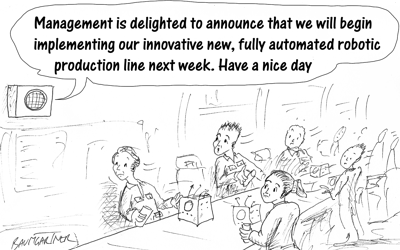
How to Make Innovative Change Work For You
By Jeffrey Baumgartner
One of the perennial problems of organisational innovation is that it results in change. And in most organisations, people don't like change. Change, at best, threatens employees' well developed routines and, at worst, threatens their jobs. An innovative improvement in the production process might cut five percent of your production costs. But it will mean changing the production process. That, in turn, means that production people will need to change their routines and some people might find that their tasks in the process are no longer required. For these people, that's scary!
Moreover the with radical innovation, there is inevitably radical change - and that tends to discomfort employees even more.
This is why employees tend to dislike change. It is also why they dislike innovation: because innovation = change in their minds. Indeed, when announcing innovations, you may well find that employees are doubtful that the new idea will work and will find all kinds of flaws in it.
What to Do
The best way to get employees to feel more positive about innovative change is to get them involved in the implementation phase and, in so doing, give them a sense of being stakeholders in the innovation. The more people feel involved, the more invested they become and the more they want innovative change to succeed.
There two things you can and should do to give people a stake in the innovation. Firstly, have a Feedback-Question session with affected employees (I'll explain that in a moment). Second, involve those employees in the implementation. Let's look at each of these.
Feedback-Question Session
Once an idea has been evaluated and approved by top management, the next step is the implementation plan. If the implementation will affect employees, you should solicit feedback from the beginning. But do not respond to the feedback with direct answers. Respond with questions that challenge the critic to define her criticism in more depth and that get her to think about answers. For example...
Criticism: It will cost much more than expected!
Question 1: Why will it cost more? What have we not anticipated when it comes to cost?
Question 2: In what ways might we reduce implementation costs?
Criticism: The customers will not like it!
Question 1: Why not? What in particular will the customers not like?
Question 2: In what ways can we make this idea more customer friendly?
By challenging employees to not only provide feedback,
but also find solutions to the problems they identify, you do two things.
Firstly, you enable them to discover that perceived flaws are not so serious as
they believe them to be. Secondly, you begin the process of making employees
stakeholders in the new ideas.
In situations where a lot of people will be affected, this exercise can be done as a facilitated group discussion in which affected employees collaborate to put together a feedback list, which is presented to the implementation team. The implementation team, in turn, can respond with questions that the group can discuss among themselves and respond accordingly.
As I trust you can see, responding to criticisms with open questions is much more respectful of the affected employees. You are, in effect, communicating that you respect their ideas and their feedback.
Questions should be open (ie, not questions that seek a “yes” or “no” answer) and non-judgemental. Responding to a feedback with, “Are you a complete idiot, or what?” would be extremely detrimental to your relationship with the affected employees and the success of your innovation.
Enable Employees to Define their Roles
Once employees become more comfortable with the concept of the innovation, the next step is to give them the opportunity to define their roles in the implementation. This does three things. It helps ensure a smoother implementation, it reassures employees that the innovation is unlikely to make them redundant and it gives them a bigger stake in the implementation. As a result, employees go from being very much against the innovative change to being stakeholders in its success.
If a lot of people will be affected by the innovative change, it is more efficient to have teams define their new roles and then present their ideas to the relevant managers and the implementation team.
Not Every Issue Can be Addressed
Needless-to-say, not every concern of every employee can be addressed. Likewise, not every employee will have a role in the implementation of every new innovation. But, by involving employees in the implementation process you minimise the resistance to change and make smoother the implementation of the idea. And that simply makes it easier to innovate!
Note this is an updated version of an article that appeared in Report 103 on 16 September 2008
R103/20170405/20080916




